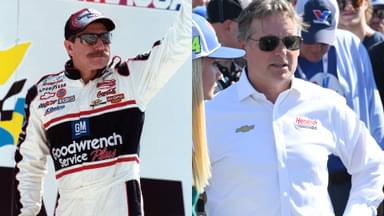When people talk about “lowriders,” they usually mean highly customized cars with chassis and suspension just an inch or two off the ground. But back in the 1990s, NASCAR had its own version of lowriders—cars whose rear ends were significantly lower than the front during qualifying at the two superspeedways: Daytona and this week’s host track, Talladega.
Advertisement
Three-time Cup champion crew chief Ray Evernham replied to a tweet of a photo of the pole-winning car he prepped for Jeff Gordon in the 1999 Daytona 500, saying that because there were no rules in NASCAR at the time, the back-end rake was seven inches lower than the front-end rake.
Dale Earnhardt Jr. also replied to the same photo, noting, “We started building cars with the frame rails raked at a very extreme angle to lower the cars even more.”
Veteran crew chief and broadcaster Larry McReynolds was one of the masters when it came to raking the back end with altered shock absorbers, creating the lowrider effect.
“We’re holding the cars down so hard that when drivers talk to us on the radio, their voices are quivering,” McReynolds recalled in a YouTube video released Wednesday by NASCARman History. “They can’t read the gauges on the dash because the car is bouncing so hard.
“You think that something that drove that harsh would not be fast, but it is. The harsher you can make it, the faster it goes.”
The lowrider concept even led to humorous — but also very true — tales.
“When I was with Jeff Burton last year, we had a set of shocks we called our ‘super-duper double down driver killers,’” said former crew chief and later NASCAR vice president Robin Pemberton. “And whenever we weren’t going fast enough at Daytona or Talladega, we’d throw them on the car.”
NASCAR initially planned to ban the lowrider shocks, but when it became clear that policing the shocks — and potentially having to remove each one from a car, open it up, and examine it — would be too difficult, the sanctioning body decided to discard the new rule and kept the lowrider effect going for a while longer.
Another element of the lowrider effect was pairing shocks — particularly the so-called “no rebound” shocks that didn’t immediately go up and back — with very soft rear springs that would compress easily.
That combination often, particularly when a car came to pit road for service, made it appear as if the back end was riding so low that it looked like the car was riding on the tailpipes, or gave the impression there were a couple of hundred extra pounds in the trunk, only to, almost timed to a split-second, have the springs and shocks pop back into position as the car prepared to go back on track.
“You’d say, ‘Watch, watch, watch, watch,’ and a car would sit there and all of a sudden it goes and it’d pop up.’ Oh, it was perfect!” Pemberton said with a laugh.
Unfortunately for crew chiefs, drivers, and teams, the no-holds-barred rule for shocks ultimately ended with the 2000 Daytona 500, when NASCAR took control of shocks out of the hands of the teams and instead provided each team with four shocks to install in their respective cars to level the playing field.
But in a Catch-22 situation, not everyone was happy with the new rule.
“That’s the worst racing I’ve seen at Daytona in a long, long time,” Dale Earnhardt quipped. “They took NASCAR Winston Cup racing and made it some of the sorriest racing, took racing out of the drivers and the crew’s hands. We can’t adjust, we can’t make our cars drive like we want. They’ve just killed the race at Daytona. That’s all I’ve got to say. Mr. Bill France Sr. (who founded NASCAR) probably would’ve rolled over in his grave if he’d seen that deal.”
Earnhardt wasn’t the only one who was critical. The 2000 edition of the Great American Race had only nine lead changes, prompting countless fans to call it one of the most boring Daytona 500s ever.
The superspeedway shocks system, however, remained in place for another 17 years. In 2018, NASCAR eliminated rules related to rear shocks, although the rake was not as extreme as it had been nearly 20 years earlier.








